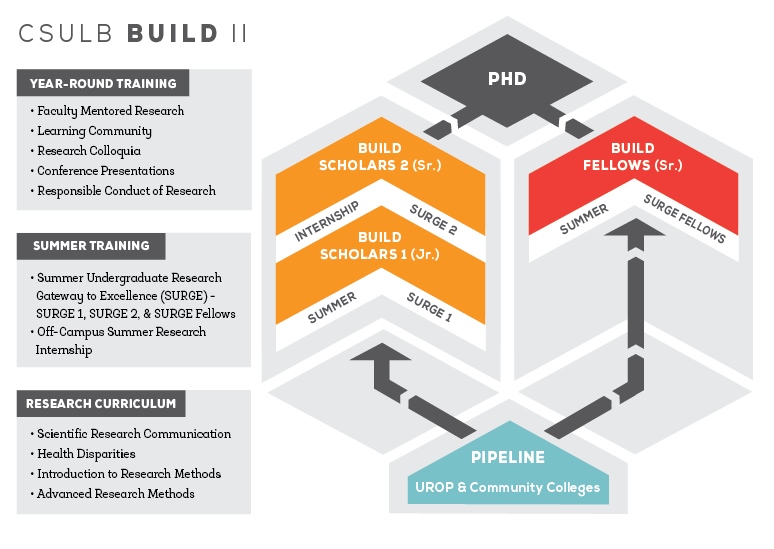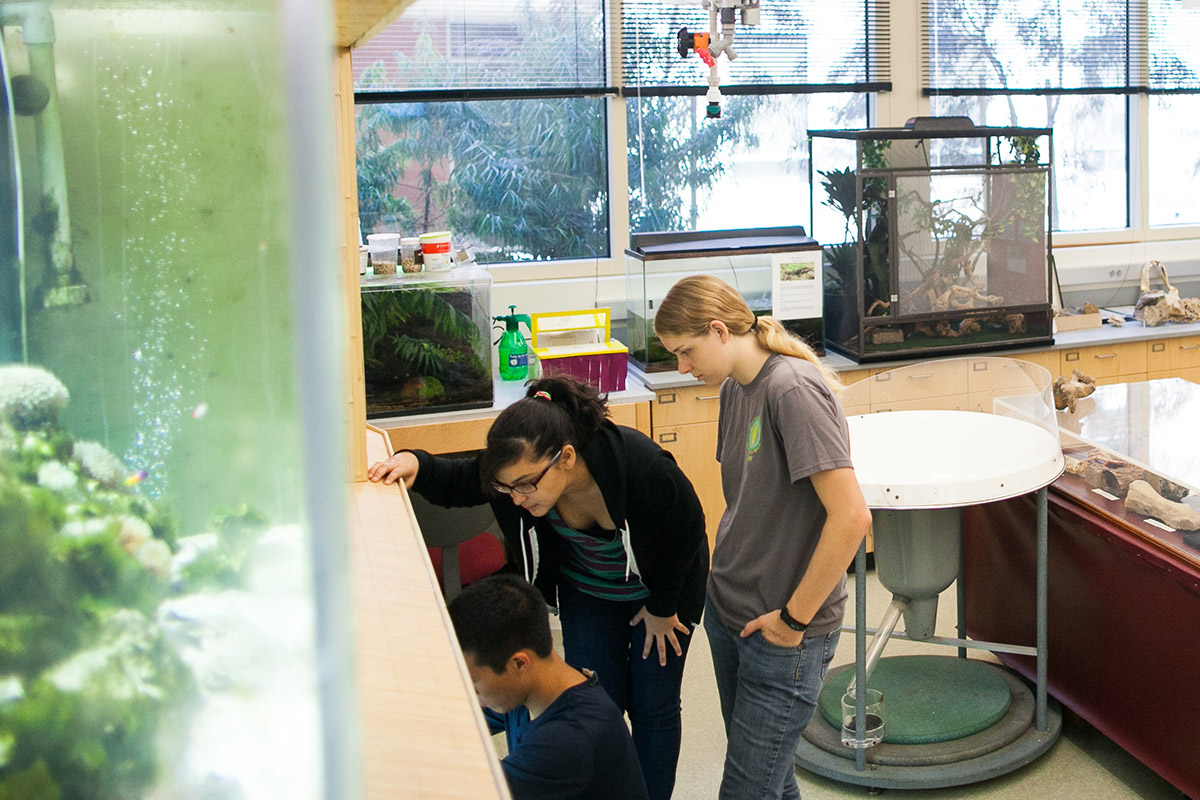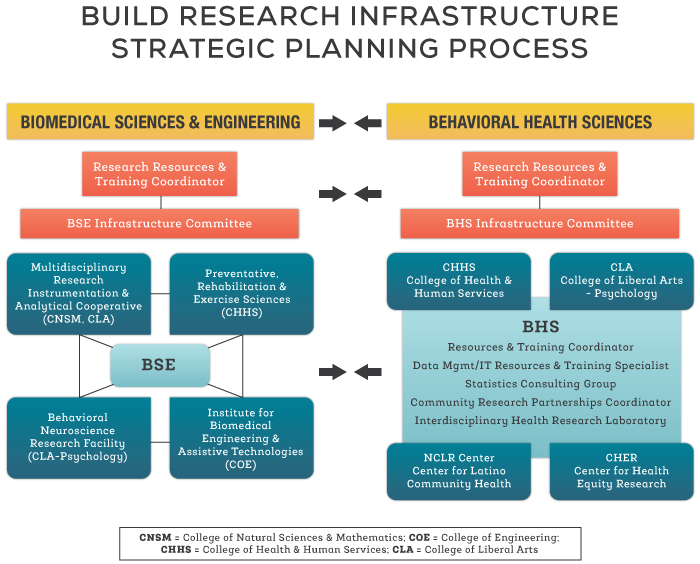About BUILD
Building Infrastructure Leading to Diversity (BUILD)

The CSULB BUILD Program offers intensive, hands-on research and training opportunities for undergraduate students designed to prepare them to excel in doctoral programs, as well as health-related research careers. It is one of 10 programs in the United States funded by the National Institutes of Health (NIH) BUILD Initiative. You can learn more about the overall national program on this National Institute of General Medical Sciences (NIGMS) page and this Diversity Program Consortium (DPC) page.
The overall goal of CSULB BUILD is to strengthen and develop a sustainable pipeline for advanced research degrees in health-related research. This type of research uses innovative methods to examine the cause, diagnosis, prevention, and treatment of diseases to improve health and well-being. It is conducted across a number of different disciplines (e.g., engineering and the behavioral, biological, clinical, physical, public health and social sciences) and can include basic, applied and translational approaches to studying a variety of health issues facing our communities and our nation.
The Importance of Research
Research uncovers and evaluates new knowledge, ideas, and technologies that are essential in driving the future of society and humanity. Without research, a relevant and modern curriculum does not exist.
In addition, research fosters professional excellence in faculty, which is important for delivering outstanding student education and training. When our next generation of practitioners and leaders--students--engage in research, with its deliberate process and requirements for critical thinking skills, they become better students and are best prepared for the challenges and opportunities of the future.
Research provides students with an opportunity to make a difference. It is open to everyone and thrives on a diversity of approaches and perspectives. From these perspectives, research is at the very center of academia.
How BUILD Works at CSULB
CSULB BUILD is committed to providing exceptional research and skills training to the next generation of scientists in order to advance scientific knowledge and technology contributing to the improvement of every individual’s health in the U.S., as well as around the world. To support this goal, CSULB BUILD engages in a variety of activities, including:
- Create an innovative, culturally responsive and transformative student training program that addresses barriers to success (institutional, structural, environmental and individual) informed by our BUILD Planning grant
- Create rigorous health-related training and mentorship opportunities for URS to become outstanding research scientists
- Bridge health-related sciences across programs, departments, and colleges with the common goal of increasing the number of URS in the health-related research workforce
- Provide faculty development activities to enhance culturally competent mentorship of URS and increase research infrastructure, competitiveness, and capacity for faculty
- Strengthen partnerships with pipeline and research campuses -- leading to increased opportunities for faculty and students
As the BUILD I program winds down, ending June 2019, we are preparing for the possibility of BUILD II, where the focus will be on institutionalizing the best practices we learned in BUILD I and disseminating information to other campuses.

Developing Research Capacity at CSULB
Another component of the BUILD program is advancing the research capacity of the campus and facilitating the infrastructure development to supporting this research. Through strategic planning and multiple investments, the BUILD Institutional Development (ID) Core provides opportunities to strengthen research skills and productivity as well as mentorship and teaching skills effective for our students.
Strategic Plan for Research Infrastructure (SPRI)
The ID Core team has been working with the University's Office of Research and Sponsored Projects (ORSP), to coordinate and implement an extensive assessment of all 'entities' at CSULB contributing to original research and scholarship, and student research training opportunities. These entities include colleges and departments, centers and institutes, specialized facilities, instrumentation, and analytical cores, and regional resources (e.g., specialized services, or expertise available at other universities or agencies). The findings of this work will be critical for the shaping and development of the new Strategic Plan for Research Infrastructure (SPRI) for CSULB.

The SPRI is intended to help all of us to leverage and integrate existing strengths, reduce costly redundancies while increasing resource sharing, and facilitate cross-campus cooperation and interdisciplinary collaboration.
The long-range goal is to develop and sustain a top caliber, high- capacity research environment that bolsters faculty research programs and student research training and education. Such a strategic plan has never existed at the university, and it is timely given our current strengths, and readiness to advance.
Two principal health-related research clusters assist the SPRI process. These include Biomedical Sciences and Engineering (BSE) and Behavioral Health Sciences (BHS). While there is ample potential for interdisciplinary collaborations between these clusters, the general infrastructure needs of the two are relatively distinct.

SPRI Process in the BSE Disciplines
Instrumentation and technologies resources are commonly located in research laboratories and in instrumentation or research core facilities. These assets form a foundation for improving research infrastructure. The process includes the following components:
- The BSE Infrastructure Committee includes broad disciplinary expertise in addition to ORSP leadership and off-campus entities
- The BSE-RTC, with the guidance of the BSE Infrastructure Committee, ID Core Directors, and ORSP are undertaking an extensive inventory of campus-wide instrumentation, facilities, expertise, and other resources existing on campus that support BSE research disciplines. This endeavor includes site visits and interviews across the campus and eventually off-campus
- The SPRI process commenced in 2015 and outcomes include planning for acquisition of future capital instrumentation and other investments, for sharing of maintenance and repair costs across campus units, and will help to identify where campus resources should be emphasized to advance BSE research. Off-campus options at our R1 partner institutions (and elsewhere) will also be identified (with negotiation for reduced rates where possible)
- Going forward, the BSE-RTC is responsible for maintaining and updating organization of BSE-related research resources, facilitating access through developing a new Research Resources and Training Web Portal and providing technical training opportunities for students and faculty (see Technical Training Opportunities)
See also: Institutional Research Resources.
SPRI Process in the BHS Disciplines
Many faculty and students in these units are engaged in research related to health disparities and minority/community health, which often include significant participation by urban community members and organizations. Unlike the heavy instrumentation requirements in BSE disciplines, infrastructure in BHS involves more need for specialized human resources that serve to facilitate community-based research and data management challenges. There is a critical need to develop a centralized structure to coordinate resource-sharing and investments, and to foster research collaborations across colleges, and centers/institutes, as well as with outside partners.
- The BHS Infrastructure Committee includes broad disciplinary expertise in addition to ORSP leadership and off-campus entities
- The BHE-RTC, working with the BHS Infrastructure Committee, ID Core Directors, and ORSP are undertaking an extensive inventory of campus-wide expertise, facilities, and other resources on campus that supports BHS research. This endeavor includes site visits and interviews across the campus and eventually off-campus.
- The SPRI process commenced in 2015 and outcomes include plans for cost-sharing to support specialized personnel and relevant BHS research equipment and resources, broad accessibility of resources to faculty and student researchers, and collaborative research opportunities
- Going forward, the BHS-RTC will serve to coordinate research resources and reduce redundancies/ share costs, foster collaborative interdisciplinary research and development of research skills and implementation, and expand access to research resources including via development of the new Research Resources and Training Web Portal and providing technical training opportunities for students and faculty (see Technical Training Opportunities)
See also: Institutional Research Resources.





